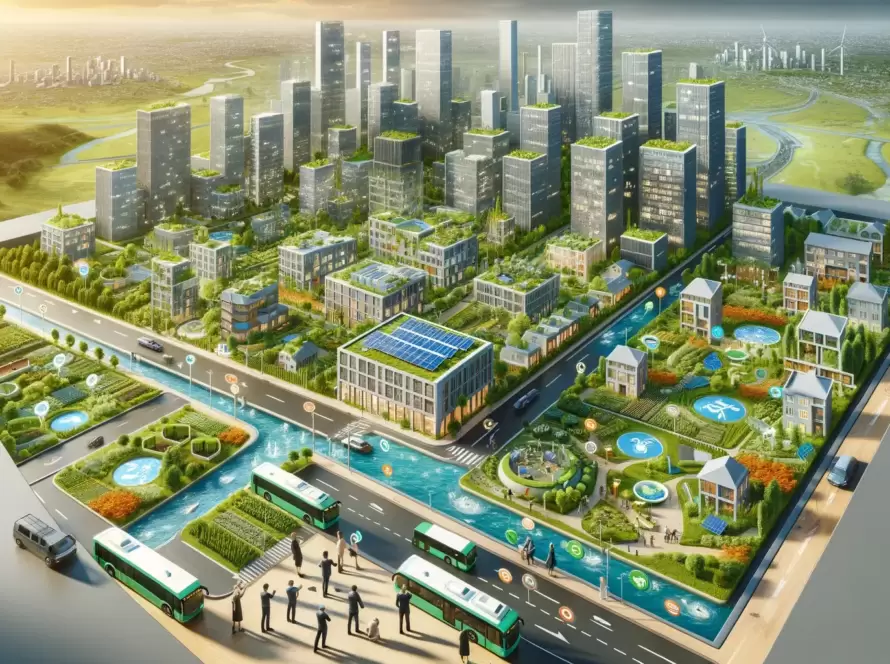
Table of Contents
In the realm of construction and architecture, rendering software has revolutionized the way professionals approach projects, from initial conceptualization to final execution. This powerful technology has not only enhanced visualization capabilities but has also streamlined communication, improved decision-making processes, and transformed project outcomes. In this comprehensive exploration, we’ll delve into how rendering software has changed the landscape of construction projects, paving the way for innovation and efficiency in the industry.
1. The Evolution of Visualization in Construction (Rendering Software)
Traditionally, architects, engineers, and construction professionals relied on 2D drawings, blueprints, and physical models to convey design concepts and project ideas. However, the advent of rendering software marked a significant shift towards immersive, photorealistic visualizations that offer a true-to-life representation of construction projects. From simple line drawings to sophisticated 3D renders, visualization tools have evolved to capture intricate details, material textures, lighting effects, and spatial relationships with unprecedented accuracy and realism.
2. Enhancing Design Clarity and Communication
Rendering software plays a pivotal role in enhancing design clarity and facilitating effective communication among project stakeholders. By visualizing designs in 3D environments, stakeholders can gain a holistic understanding of project concepts, spatial layouts, and design intent, reducing misinterpretations and errors early in the project lifecycle. Realistic renderings enable designers, clients, contractors, and investors to collaborate seamlessly, discuss design iterations, explore alternatives, and make informed decisions that align with project goals and objectives.
3. Streamlining Pre-construction Planning
Pre-construction planning involves meticulous coordination of design elements, construction methodologies, material specifications, and budget considerations. Rendering software streamlines pre-construction planning by visualizing architectural designs, structural systems, MEP (mechanical, electrical, plumbing) layouts, and building components in detail. This visual clarity allows teams to identify potential conflicts, optimize space utilization, plan logistics, and mitigate risks proactively, laying a strong foundation for successful project execution.
4. Enabling Virtual Prototyping and Design Iterations
Virtual prototyping facilitated by rendering software enables designers and engineers to test design concepts, simulate construction sequences, and evaluate performance parameters before physical implementation. Iterative design processes supported by 3D modeling, rendering, and simulation tools empower teams to refine designs, assess structural integrity, analyze energy efficiency, and validate design assumptions iteratively. This iterative approach minimizes design flaws, rework costs, and project delays, leading to optimized design solutions and superior project outcomes.
5. Visualizing Construction Sequences and Phases
Rendering software extends beyond static renderings to dynamic visualizations that depict construction sequences, phases, and progress timelines effectively. Construction phasing animations, time-lapse simulations, and 4D visualizations synchronize design data with construction schedules, allowing stakeholders to visualize project evolution over time. This visual clarity aids in project scheduling, resource allocation, site logistics planning, and coordination of sequential tasks, optimizing construction workflows and ensuring project milestones are met efficiently.
6. Improving Client Engagement and Satisfaction
Visual storytelling powered by rendering software enhances client engagement and satisfaction by presenting designs in immersive, interactive formats that resonate with clients’ visions and expectations. Clients can explore virtual walkthroughs, experience spatial layouts, visualize material finishes, and interact with design elements virtually, fostering a deeper connection with the project before construction begins. Clear communication facilitated by realistic renderings builds trust, manages expectations, and enhances overall client satisfaction throughout the project lifecycle.
7. Facilitating Regulatory Compliance and Documentation
Rendering software plays a crucial role in facilitating regulatory compliance, permitting processes, and documentation requirements for construction projects. Accurate 3D models, detailed renderings, and documentation annotations help align designs with building codes, zoning regulations, accessibility standards, and environmental guidelines. Compliance checks, simulations for fire safety, energy performance analysis, and clash detection ensure project designs meet regulatory requirements, certifications, and sustainability goals effectively.
8. Enhancing Project Marketing and Stakeholder Presentations
High-quality renderings and visualizations produced by rendering software serve as powerful marketing assets for construction projects, attracting investors, stakeholders, and prospective buyers. Compelling visual presentations, renderings, animations, and VR experiences showcase project features, amenities, and design excellence, enticing interest and investment opportunities. Strategic use of rendering software in marketing campaigns, websites, and presentations elevates project visibility, brand reputation, and market competitiveness in the construction industry.
9. Integrating with Building Information Modeling (BIM) Workflows
Rendering software seamlessly integrates with Building Information Modeling (BIM) workflows, enriching data-rich BIM models with realistic visualizations and design narratives. BIM-enabled rendering tools enhance collaboration, data interoperability, and project coordination among multidisciplinary teams involved in the design, construction, and facility management phases. This integration ensures design intent is preserved, construction conflicts are minimized, and operational efficiencies are maximized throughout the building lifecycle.
10. Embracing Future Trends and Innovations


As technology continues to advance, rendering software evolves with emerging trends and innovations shaping the construction industry. Trends such as real-time rendering, augmented reality (AR), virtual reality (VR), cloud-based rendering services, generative design, and AI-driven optimizations propel the future of architectural visualization and construction workflows. Embracing these innovations, upskilling teams, and leveraging rendering software strategically position construction professionals for continued success, creativity, and competitiveness in an ever-evolving market landscape.
In conclusion, rendering software has indeed transformed the way we approach construction projects, offering unprecedented visualization capabilities, design insights, collaboration opportunities, and project efficiencies across the project lifecycle. Embracing rendering technologies, integrating them into workflows, and leveraging their full potential empower construction teams to innovate, communicate effectively, deliver exceptional projects, and shape the future of the built environment with precision and creativity.


